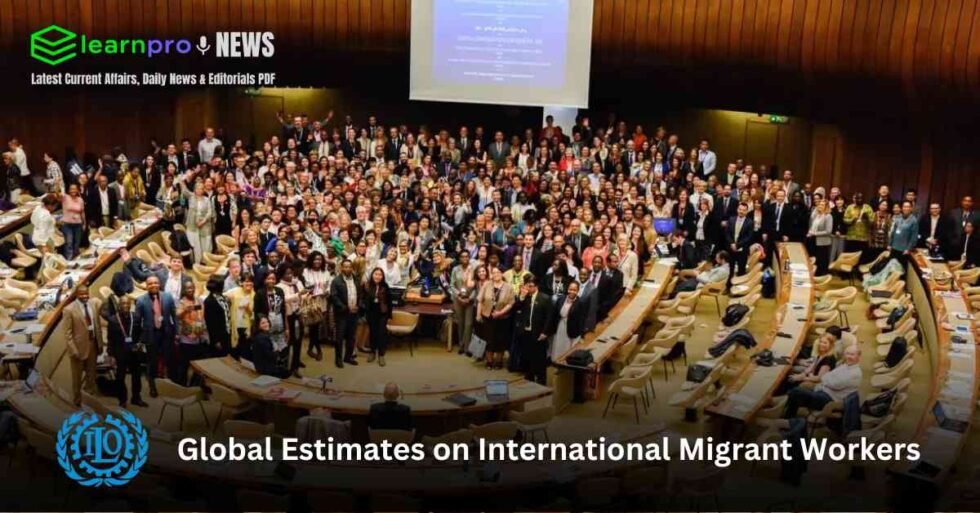
The International Labour Organization (ILO), in its fourth edition of the Global Estimates on International Migrant Workers, highlights the critical role played by international migrants (IMs) in addressing global labor market shortages and contributing to economic growth through remittances. The report, covering the period up to 2022, provides detailed insights into the composition, distribution, and economic contribution of IMs worldwide.
What Did the ILO Report State About International Migrants?
- Significant Presence in the Global Labour Force
- IMs made up 4.7% of the global labor force in 2022, equivalent to 167.7 million individuals.
- Of this total, 155.6 million were employed, and 12.1 million were unemployed but available for work.
- The total number of IMs in the global workforce increased by over 30 million since 2013, though the annual growth rate slowed to less than 1% between 2019-2022, largely due to the COVID-19 pandemic.
- Prime Age Dominance
- Prime-age workers (25-54 years) constituted 74.9% of all IM workers in 2022, reflecting the preference for economically active individuals in migration patterns.
- Youth workers (15-24 years) accounted for only 9.3%, and those above 65 years made up 3.4%, underscoring the relatively small contribution of younger and older migrants to the labor force.
- Sectoral Concentration
- The services sector absorbed the majority of IMs, at 68.4%, with women dominating this area at 80.7%, compared to 60.8% for men.
- Industry employed 24.3% of IMs, while agriculture accounted for just 7.4%, significantly lower than the 24.3% share of non-migrant workers in agriculture.

Why Are There More Male International Migrants in the Global Labour Force Than Women?
- Lower Representation in the Migrant Population
- Women constitute a smaller proportion of the total international migrant population, leading to their reduced presence in the global labor force.
- Cultural and Social Constraints
- In many countries, societal norms and cultural expectations limit women’s mobility and labor force participation, restricting their opportunities to migrate for work.
- Sectoral Preferences and Opportunities
- While women dominate in sectors such as healthcare and domestic work, men often migrate for employment in construction, manufacturing, and other labor-intensive industries, which typically offer more jobs.
- Informal Sector Employment
- A significant number of female migrants are engaged in the informal economy, making their participation in formal labor force statistics less visible.
Which Countries Absorb the Most International Migrant Workers?
- High-Income Countries as Primary Destinations
- 68.4% of IMs (114 million people) work in high-income countries, primarily in the services sector, including healthcare and caregiving.
- The concentration of IMs in high-income regions reflects the aging populations, demand in the care economy, and broader economic opportunities in these countries.
- Upper-Middle-Income Countries
- Around 17.4% (29.2 million) of IMs are employed in upper-middle-income countries, which serve as important destinations for regional migration.
- Regional Breakdown
- Northern, Southern, and Western Europe: Account for 23.3% of IM workers, with a steady increase since 2013.
- Northern America: Represents 22.6%, though its share decreased slightly over the last decade.
- Arab States: Host 13.3% of IM workers, a decline from previous years due to fluctuating oil economies and changing regional priorities.
- Future Trends
- High-income countries are expected to remain attractive destinations due to aging populations, the rise of the care economy, and sustained economic opportunities.
Sectoral Distribution of Migrant Workers
- Services Sector
- IMs dominate the services industry, with 68.4% of all migrant workers employed in this sector.
- Women hold a higher share, at 80.7%, as they are heavily represented in caregiving, domestic work, and health services.
- Industry
- IMs account for 24.3% of the global industrial workforce, reflecting their significant presence in manufacturing, construction, and related sectors.
- Agriculture
- Only 7.4% of IMs work in agriculture, in stark contrast to the 24.3% of non-migrants engaged in this sector. This highlights the preference of IMs for opportunities in urbanized and industrialized areas.
Conclusion
The ILO’s report underscores the vital role of international migrants in driving economic growth, addressing labor shortages, and supporting their home countries through remittances. While challenges persist, such as gender disparities and sectoral imbalances, IMs remain indispensable to the global labor market. High-income countries will continue to serve as primary destinations, driven by demographic trends and economic opportunities, while the services sector will remain a focal point of migrant employment. For a sustainable future, global policymakers must prioritize the integration, welfare, and equal opportunities for migrant workers across sectors and regions.






